Qing Xu
Michael
LinguaSim: Interactive Multi-Vehicle Testing Scenario Generation via Natural Language Instruction Based on Large Language Models
Oct 09, 2025Abstract:The generation of testing and training scenarios for autonomous vehicles has drawn significant attention. While Large Language Models (LLMs) have enabled new scenario generation methods, current methods struggle to balance command adherence accuracy with the realism of real-world driving environments. To reduce scenario description complexity, these methods often compromise realism by limiting scenarios to 2D, or open-loop simulations where background vehicles follow predefined, non-interactive behaviors. We propose LinguaSim, an LLM-based framework that converts natural language into realistic, interactive 3D scenarios, ensuring both dynamic vehicle interactions and faithful alignment between the input descriptions and the generated scenarios. A feedback calibration module further refines the generation precision, improving fidelity to user intent. By bridging the gap between natural language and closed-loop, interactive simulations, LinguaSim constrains adversarial vehicle behaviors using both the scenario description and the autonomous driving model guiding them. This framework facilitates the creation of high-fidelity scenarios that enhance safety testing and training. Experiments show LinguaSim can generate scenarios with varying criticality aligned with different natural language descriptions (ACT: 0.072 s for dangerous vs. 3.532 s for safe descriptions; comfortability: 0.654 vs. 0.764), and its refinement module effectively reduces excessive aggressiveness in LinguaSim's initial outputs, lowering the crash rate from 46.9% to 6.3% to better match user intentions.
MasHost Builds It All: Autonomous Multi-Agent System Directed by Reinforcement Learning
Jun 12, 2025Abstract:Large Language Model (LLM)-driven Multi-agent systems (Mas) have recently emerged as a powerful paradigm for tackling complex real-world tasks. However, existing Mas construction methods typically rely on manually crafted interaction mechanisms or heuristic rules, introducing human biases and constraining the autonomous ability. Even with recent advances in adaptive Mas construction, existing systems largely remain within the paradigm of semi-autonomous patterns. In this work, we propose MasHost, a Reinforcement Learning (RL)-based framework for autonomous and query-adaptive Mas design. By formulating Mas construction as a graph search problem, our proposed MasHost jointly samples agent roles and their interactions through a unified probabilistic sampling mechanism. Beyond the accuracy and efficiency objectives pursued in prior works, we introduce component rationality as an additional and novel design principle in Mas. To achieve this multi-objective optimization, we propose Hierarchical Relative Policy Optimization (HRPO), a novel RL strategy that collaboratively integrates group-relative advantages and action-wise rewards. To our knowledge, our proposed MasHost is the first RL-driven framework for autonomous Mas graph construction. Extensive experiments on six benchmarks demonstrate that MasHost consistently outperforms most competitive baselines, validating its effectiveness, efficiency, and structure rationality.
HRMedSeg: Unlocking High-resolution Medical Image segmentation via Memory-efficient Attention Modeling
Apr 08, 2025Abstract:High-resolution segmentation is critical for precise disease diagnosis by extracting micro-imaging information from medical images. Existing transformer-based encoder-decoder frameworks have demonstrated remarkable versatility and zero-shot performance in medical segmentation. While beneficial, they usually require huge memory costs when handling large-size segmentation mask predictions, which are expensive to apply to real-world scenarios. To address this limitation, we propose a memory-efficient framework for high-resolution medical image segmentation, called HRMedSeg. Specifically, we first devise a lightweight gated vision transformer (LGViT) as our image encoder to model long-range dependencies with linear complexity. Then, we design an efficient cross-multiscale decoder (ECM-Decoder) to generate high-resolution segmentation masks. Moreover, we utilize feature distillation during pretraining to unleash the potential of our proposed model. Extensive experiments reveal that HRMedSeg outperforms state-of-the-arts in diverse high-resolution medical image segmentation tasks. In particular, HRMedSeg uses only 0.59GB GPU memory per batch during fine-tuning, demonstrating low training costs. Besides, when HRMedSeg meets the Segment Anything Model (SAM), our HRMedSegSAM takes 0.61% parameters of SAM-H. The code is available at https://github.com/xq141839/HRMedSeg.
DenseFormer: Learning Dense Depth Map from Sparse Depth and Image via Conditional Diffusion Model
Mar 31, 2025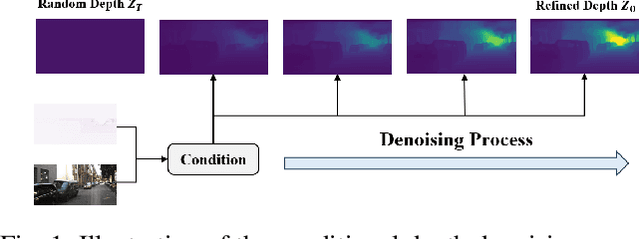
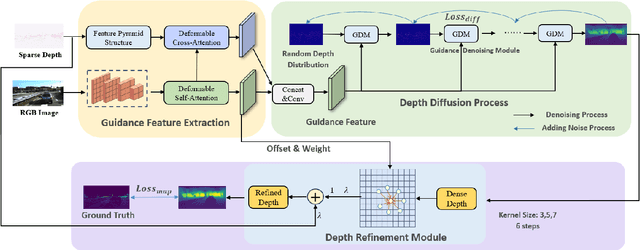
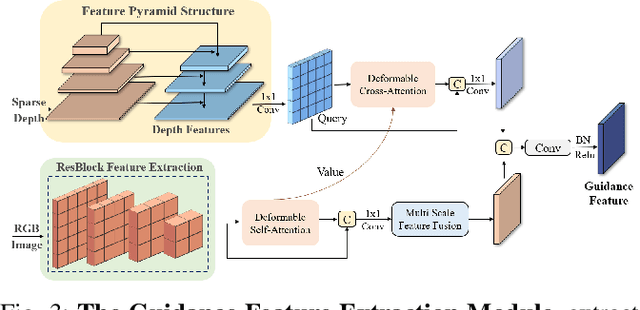
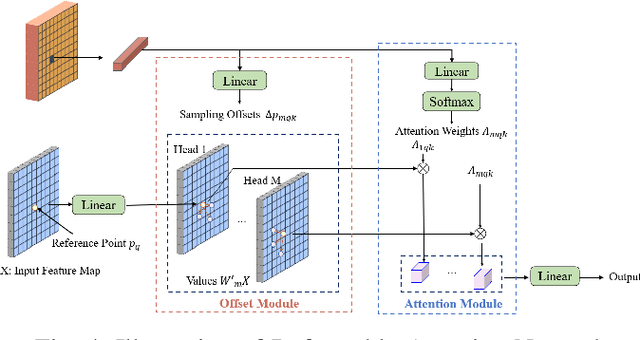
Abstract:The depth completion task is a critical problem in autonomous driving, involving the generation of dense depth maps from sparse depth maps and RGB images. Most existing methods employ a spatial propagation network to iteratively refine the depth map after obtaining an initial dense depth. In this paper, we propose DenseFormer, a novel method that integrates the diffusion model into the depth completion task. By incorporating the denoising mechanism of the diffusion model, DenseFormer generates the dense depth map by progressively refining an initial random depth distribution through multiple iterations. We propose a feature extraction module that leverages a feature pyramid structure, along with multi-layer deformable attention, to effectively extract and integrate features from sparse depth maps and RGB images, which serve as the guiding condition for the diffusion process. Additionally, this paper presents a depth refinement module that applies multi-step iterative refinement across various ranges to the dense depth results generated by the diffusion process. The module utilizes image features enriched with multi-scale information and sparse depth input to further enhance the accuracy of the predicted depth map. Extensive experiments on the KITTI outdoor scene dataset demonstrate that DenseFormer outperforms classical depth completion methods.
EmoHead: Emotional Talking Head via Manipulating Semantic Expression Parameters
Mar 25, 2025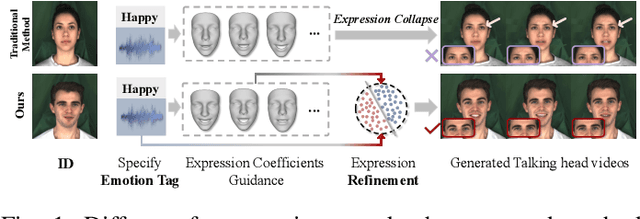
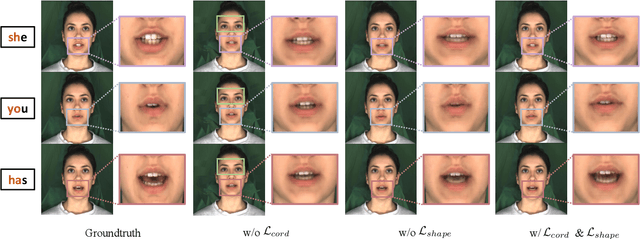
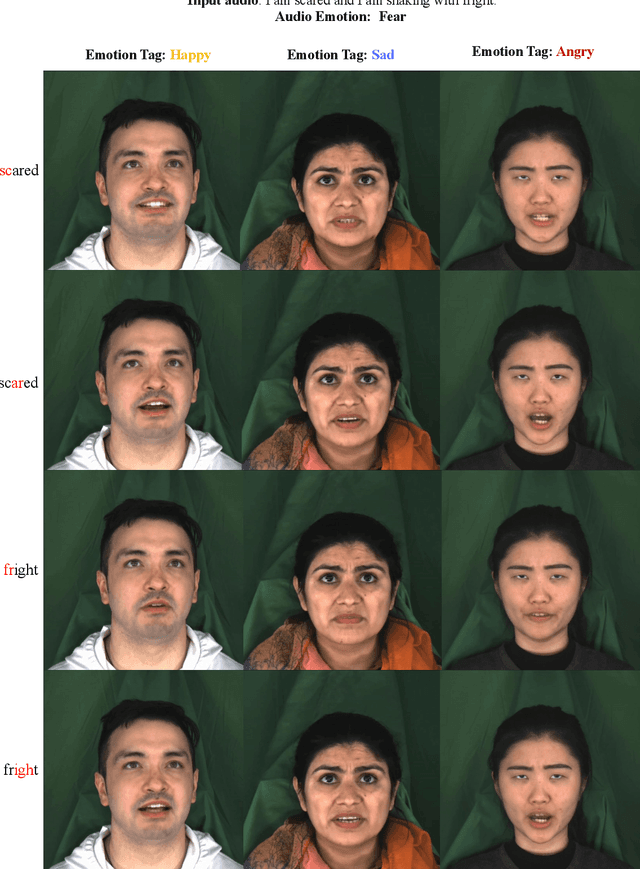
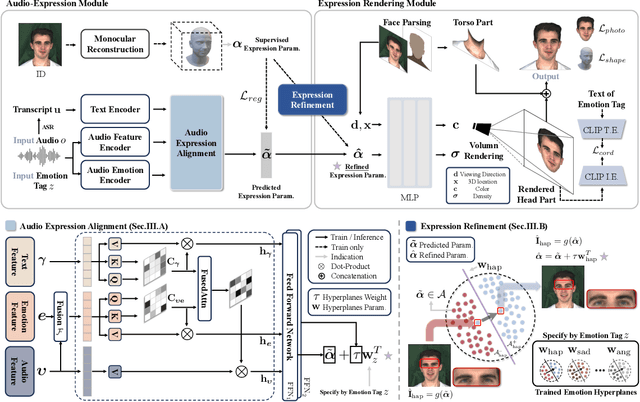
Abstract:Generating emotion-specific talking head videos from audio input is an important and complex challenge for human-machine interaction. However, emotion is highly abstract concept with ambiguous boundaries, and it necessitates disentangled expression parameters to generate emotionally expressive talking head videos. In this work, we present EmoHead to synthesize talking head videos via semantic expression parameters. To predict expression parameter for arbitrary audio input, we apply an audio-expression module that can be specified by an emotion tag. This module aims to enhance correlation from audio input across various emotions. Furthermore, we leverage pre-trained hyperplane to refine facial movements by probing along the vertical direction. Finally, the refined expression parameters regularize neural radiance fields and facilitate the emotion-consistent generation of talking head videos. Experimental results demonstrate that semantic expression parameters lead to better reconstruction quality and controllability.
RS2V-L: Vehicle-Mounted LiDAR Data Generation from Roadside Sensor Observations
Mar 10, 2025Abstract:End-to-end autonomous driving solutions, which process multi-modal sensory data to directly generate refined control commands, have become a dominant paradigm in autonomous driving research. However, these approaches predominantly depend on single-vehicle data collection for model training and optimization, resulting in significant challenges such as high data acquisition and annotation costs, the scarcity of critical driving scenarios, and fragmented datasets that impede model generalization. To mitigate these limitations, we introduce RS2V-L, a novel framework for reconstructing and synthesizing vehicle-mounted LiDAR data from roadside sensor observations. Specifically, our method transforms roadside LiDAR point clouds into the vehicle-mounted LiDAR coordinate system by leveraging the target vehicle's relative pose. Subsequently, high-fidelity vehicle-mounted LiDAR data is synthesized through virtual LiDAR modeling, point cloud classification, and resampling techniques. To the best of our knowledge, this is the first approach to reconstruct vehicle-mounted LiDAR data from roadside sensor inputs. Extensive experimental evaluations demonstrate that incorporating the generated data into model training-complementing the KITTI dataset-enhances 3D object detection accuracy by over \text{30\%} while improving the efficiency of end-to-end autonomous driving data generation by more than an order of magnitude. These findings strongly validate the effectiveness of the proposed method and underscore its potential in reducing dependence on costly vehicle-mounted data collection while improving the robustness of autonomous driving models.
CFFormer: Cross CNN-Transformer Channel Attention and Spatial Feature Fusion for Improved Segmentation of Low Quality Medical Images
Jan 07, 2025Abstract:Hybrid CNN-Transformer models are designed to combine the advantages of Convolutional Neural Networks (CNNs) and Transformers to efficiently model both local information and long-range dependencies. However, most research tends to focus on integrating the spatial features of CNNs and Transformers, while overlooking the critical importance of channel features. This is particularly significant for model performance in low-quality medical image segmentation. Effective channel feature extraction can significantly enhance the model's ability to capture contextual information and improve its representation capabilities. To address this issue, we propose a hybrid CNN-Transformer model, CFFormer, and introduce two modules: the Cross Feature Channel Attention (CFCA) module and the X-Spatial Feature Fusion (XFF) module. The model incorporates dual encoders, with the CNN encoder focusing on capturing local features and the Transformer encoder modeling global features. The CFCA module filters and facilitates interactions between the channel features from the two encoders, while the XFF module effectively reduces the significant semantic information differences in spatial features, enabling a smooth and cohesive spatial feature fusion. We evaluate our model across eight datasets covering five modalities to test its generalization capability. Experimental results demonstrate that our model outperforms current state-of-the-art (SOTA) methods, with particularly superior performance on datasets characterized by blurry boundaries and low contrast.
V2X-DGPE: Addressing Domain Gaps and Pose Errors for Robust Collaborative 3D Object Detection
Jan 04, 2025



Abstract:In V2X collaborative perception, the domain gaps between heterogeneous nodes pose a significant challenge for effective information fusion. Pose errors arising from latency and GPS localization noise further exacerbate the issue by leading to feature misalignment. To overcome these challenges, we propose V2X-DGPE, a high-accuracy and robust V2X feature-level collaborative perception framework. V2X-DGPE employs a Knowledge Distillation Framework and a Feature Compensation Module to learn domain-invariant representations from multi-source data, effectively reducing the feature distribution gap between vehicles and roadside infrastructure. Historical information is utilized to provide the model with a more comprehensive understanding of the current scene. Furthermore, a Collaborative Fusion Module leverages a heterogeneous self-attention mechanism to extract and integrate heterogeneous representations from vehicles and infrastructure. To address pose errors, V2X-DGPE introduces a deformable attention mechanism, enabling the model to adaptively focus on critical parts of the input features by dynamically offsetting sampling points. Extensive experiments on the real-world DAIR-V2X dataset demonstrate that the proposed method outperforms existing approaches, achieving state-of-the-art detection performance. The code is available at https://github.com/wangsch10/V2X-DGPE.
Conformal Symplectic Optimization for Stable Reinforcement Learning
Dec 03, 2024



Abstract:Training deep reinforcement learning (RL) agents necessitates overcoming the highly unstable nonconvex stochastic optimization inherent in the trial-and-error mechanism. To tackle this challenge, we propose a physics-inspired optimization algorithm called relativistic adaptive gradient descent (RAD), which enhances long-term training stability. By conceptualizing neural network (NN) training as the evolution of a conformal Hamiltonian system, we present a universal framework for transferring long-term stability from conformal symplectic integrators to iterative NN updating rules, where the choice of kinetic energy governs the dynamical properties of resulting optimization algorithms. By utilizing relativistic kinetic energy, RAD incorporates principles from special relativity and limits parameter updates below a finite speed, effectively mitigating abnormal gradient influences. Additionally, RAD models NN optimization as the evolution of a multi-particle system where each trainable parameter acts as an independent particle with an individual adaptive learning rate. We prove RAD's sublinear convergence under general nonconvex settings, where smaller gradient variance and larger batch sizes contribute to tighter convergence. Notably, RAD degrades to the well-known adaptive moment estimation (ADAM) algorithm when its speed coefficient is chosen as one and symplectic factor as a small positive value. Experimental results show RAD outperforming nine baseline optimizers with five RL algorithms across twelve environments, including standard benchmarks and challenging scenarios. Notably, RAD achieves up to a 155.1% performance improvement over ADAM in Atari games, showcasing its efficacy in stabilizing and accelerating RL training.
Vision-Driven 2D Supervised Fine-Tuning Framework for Bird's Eye View Perception
Sep 09, 2024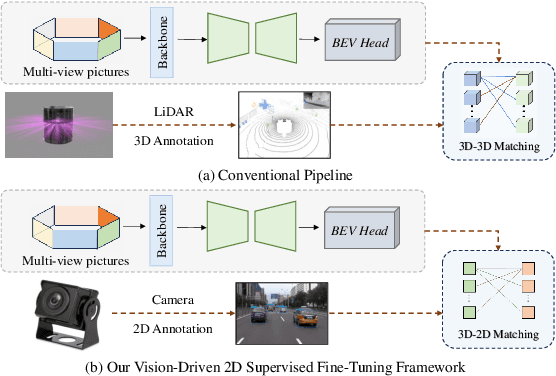
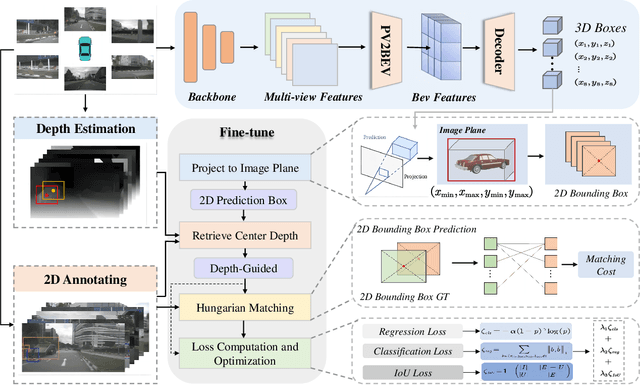
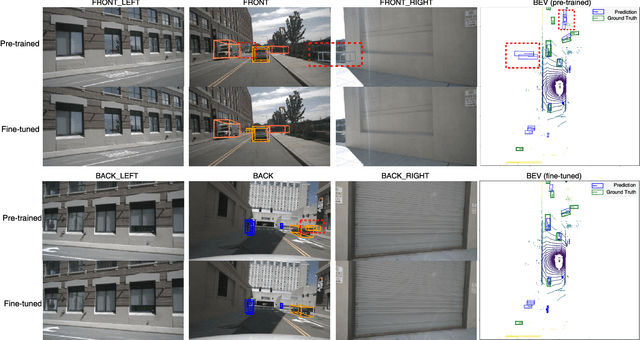

Abstract:Visual bird's eye view (BEV) perception, due to its excellent perceptual capabilities, is progressively replacing costly LiDAR-based perception systems, especially in the realm of urban intelligent driving. However, this type of perception still relies on LiDAR data to construct ground truth databases, a process that is both cumbersome and time-consuming. Moreover, most massproduced autonomous driving systems are only equipped with surround camera sensors and lack LiDAR data for precise annotation. To tackle this challenge, we propose a fine-tuning method for BEV perception network based on visual 2D semantic perception, aimed at enhancing the model's generalization capabilities in new scene data. Considering the maturity and development of 2D perception technologies, our method significantly reduces the dependency on high-cost BEV ground truths and shows promising industrial application prospects. Extensive experiments and comparative analyses conducted on the nuScenes and Waymo public datasets demonstrate the effectiveness of our proposed method.
 Add to Chrome
Add to Chrome Add to Firefox
Add to Firefox Add to Edge
Add to Edge